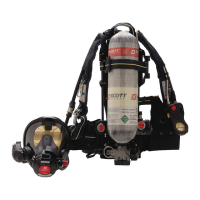16
WARNING
USE OF THE RESPIRATOR WITHOUT FAS-
TENING AND ADJUSTING THE SHOULDER
STRAPS AND THE WAIST BELT AND SE-
CURING LOOSE ENDS OF BELT AS
DESCRIBED IN THIS INSTRUCTION MAY
RESULT IN SHIFTING OF THE RESPIRATOR
ON THE USER'S BODY, SNAGGING THE
BELT, OR IN SEPARATION OF THE RESPI-
RATOR FROM THE USER'S BODY WHICH
COULD DISTURB THE FACE TO FACEPIECE
SEAL AND WHICH MAY RESULT IN EXPO-
SURE OF THE USER TO THE ATMOSPHERE
THE RESPIRATOR IS INTENDED TO PRO-
TECT AGAINST RESULTING IN SERIOUS
INJURY OR DEATH.
WARNING
IF PASS DEVICE DISTRESS ALARM FAILS
TO FUNCTION IN ACCORDANCE WITH THE
INSTRUCTIONS SUPPLIED WITH THE DIS-
TRESS ALARM, DO NOT USE THE
RESPIRATOR. REMOVE IT FROM SERVICE
AND TAG FOR REPAIR BY AUTHORIZED
PERSONNEL. USE OF A RESPIRATOR WITH
A MALFUNCTIONING DISTRESS ALARM
MAY RESULT IN SERIOUS INJURY OR
DEATH.
WARNING
IF THE END OF SERVICE INDICATOR
ALARMS DO NOT ACTUATE AS DESCRIBED
IN THIS INSTRUCTION, DO NOT USE THE
RESPIRATOR. REMOVE THE RESPIRATOR
FROM SERVICE AND TAG IT FOR REPAIR
BY AUTHORIZED PERSONNEL. USE OF A
RESPIRATOR WITH A MALFUNCTIONING
END OF SERVICE INDICATOR MAY RESULT
IN SERIOUS INJURY OR DEATH.
WARNING
THE CYLINDER VALVE MUST BE FULLY
OPENED FOR PROPER OPERATION OF
THE RESPIRATOR. USE OF A RESPIRATOR
WITH THE CYLINDER VALVE PARTIALLY
OPENED MAY CAUSE A REDUCTION OF
THE AIR SUPPLIED TO THE USER AND/OR
A SUDDEN AND COMPLETE LOSS OF AIR
SUPPLIED TO THE USER. A REDUCTION
OR LOSS OF AIR TO THE USER MAY RE-
SULT IN SERIOUS INJURY OR DEATH.
PREPARATION FOR USE
1. If carrying case is used for storage, proceed as follows:
Place carrying case on ground or level surface, open lid (hard case) or
top flap (soft case). Check cylinder gauge for “FULL” indication. If not
full, replace cylinder before use. A gauge indication of other than full
may indicate an air leak in the cylinder and valve assembly or a mal-
function of the gauge assembly. Ensure that the cylinder is firmly locked
in position by the cylinder retention assembly. Stand the respirator on
the cylinder valve with cylinder toward you and the shoulder straps
away from you. Grasp both shoulder straps by the top, one in each
hand. Pick up the respirator and swing it around behind you. Re-
lease your grasp while sliding your arms under the shoulder straps.
Ensure that the shoulder straps fall into place on the shoulders. Pull
down on the side straps to adjust the harness to fit your body.
If storage bracket is used, proceed as follows:
Check the cylinder gauge for “FULL” indication. If not full, replace
cylinder before use. A gauge indication of other than full may in-
dicate an air leak in the cylinder and valve assembly or a mal-
function of the gauge assembly. Ensure that the cylinder is firmly
locked in position by the cylinder retention assembly. Follow the
instructions of the bracket manufacturer for placing arms through
shoulder straps and freeing the respirator from the bracket.
2. Connect the waist belt buckle and adjust by pulling forward on the
two (2) side-mounted belt ends. Tuck belt ends into waistband.
3. Readjust shoulder straps to ensure the weight is carried on the
hips. Tuck in ends of shoulder straps.
4. Fully depress center of the air saver/donning switch on top of regu-
lator and release. The regulator may be, but does not have to be,
installed in the facepiece at this time (see step 6 below).
5. Slowly open cylinder valve fully by turning the valve knob coun-
terclockwise until it stops (approximately 2 1/2 full turns of the
knob). The VIBRALERT end of service indicator alarm will actu-
ate and then stop. The HEADS-UP DISPLAY shall initialize for
twenty (20) seconds and then display the cylinder level.
The respirator is equipped with a PASS DEVICE distress alarm
which will actuate when the cylinder valve is opened and will sound
three quick audible chirps accompanied by a green flashing on the
PASS DEVICE control console. Refer to the operating and main-
tenance instructions for PASS DEVICE distress alarm for complete
information on the distress alarm operation.
If the air saver/donning switch has not been depressed prior to
opening the cylinder valve, the VIBRALERT Alarm will not actu-
ate due to the air flowing freely on the facepiece.
6. The user of the respirator is now in “standby” condition. The res-
pirator is in place on the user's body but the facepiece is not
donned (sealed to the face) and the respirator is not being used.
The regulator is retained in the facepiece by a 1/4 turn port and
is locked in the facepiece retainer with a lock tab. To detach the
regulator from the facepiece while in “standby” condition, place
your right hand over the cover with your thumb on the lock tab.
Pull the lock tab toward the cover and rotate the regulator 1/4 turn
clockwise (viewed from inside of facepiece). When the red purge
valve is in the 12 o’clock position remove regulator from the face-
piece. An optional regulator holder which attaches to the user’s
belt and a facepiece neck strap are available for use during
“standby” condition. See the ACCESSORIES section of this in-
struction.

